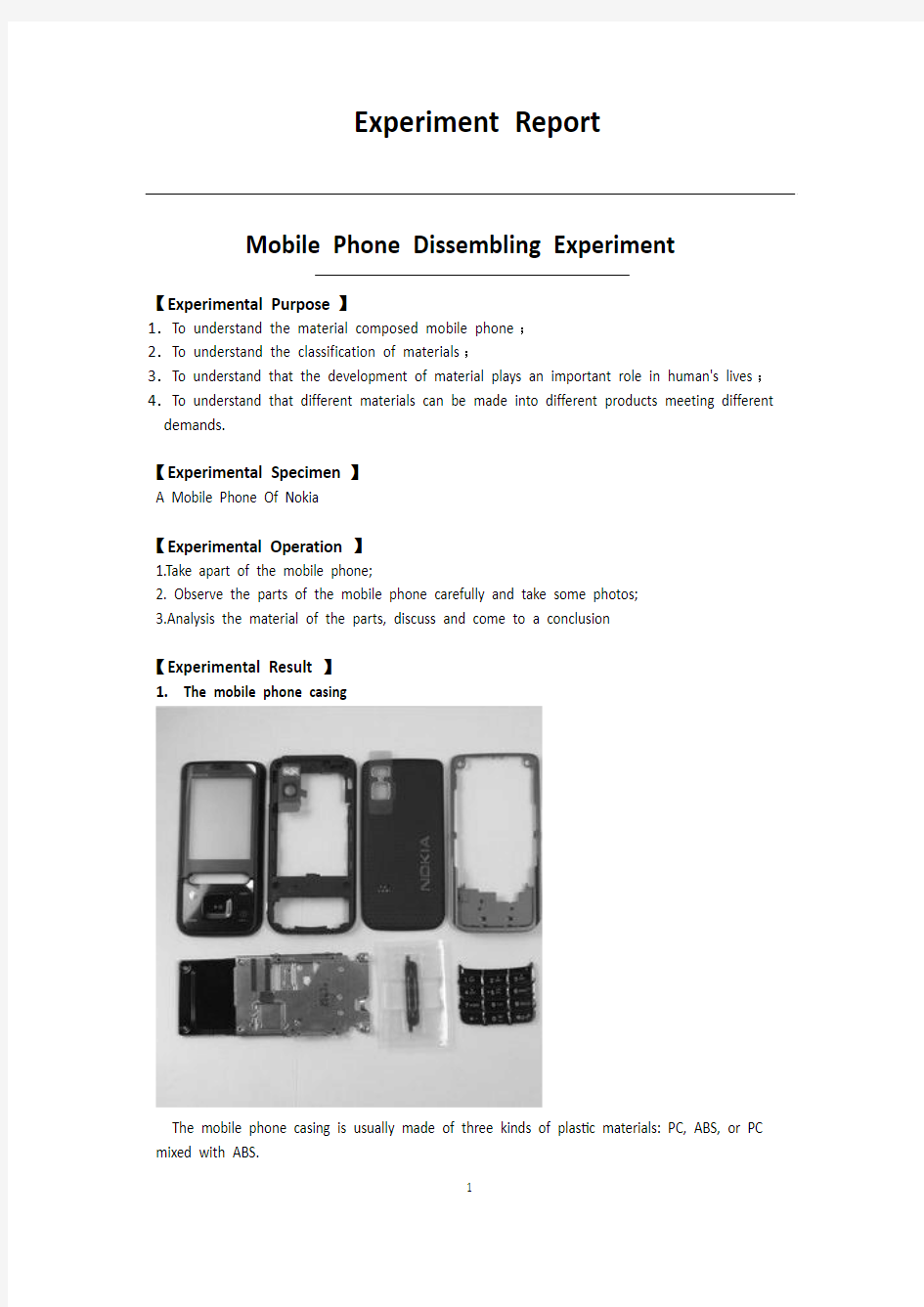Experiment Report

- 1、下载文档前请自行甄别文档内容的完整性,平台不提供额外的编辑、内容补充、找答案等附加服务。
- 2、"仅部分预览"的文档,不可在线预览部分如存在完整性等问题,可反馈申请退款(可完整预览的文档不适用该条件!)。
- 3、如文档侵犯您的权益,请联系客服反馈,我们会尽快为您处理(人工客服工作时间:9:00-18:30)。
Experiment Report
Mobile Phone Dissembling Experiment
【Experimental Purpose】
1.To understand the material composed mobile phone;
2.To understand the classification of materials;
3.To understand that the development of material plays an important role in human's lives;4.To understand that different materials can be made into different products meeting different demands.
【Experimental Specimen】
A Mobile Phone Of Nokia
【Experimental Operation】
1.Take apart of the mobile phone;
2. Observe the parts of the mobile phone carefully and take some photos;
3.Analysis the material of the parts, discuss and come to a conclusion
【Experimental Result】
1.The mobile phone casing
The mobile phone casing is usually made of three kinds of plastic materials: PC, ABS, or PC mixed with ABS.
1)
PC
Polycarbonate(PC) is a very durable material. Although it has high impact-resistance, it has low scratch-resistance and so a hard coating is applied to polycarbonate eyewear lenses and polycarbonate exterior automotive components. The characteristics of polycarbonate are quite like those of polymethyl methacrylate (PMMA, acrylic), but polycarbonate is stronger, usable in a wider temperature range but more expensive. This polymer is highly transparent to visible light and has better light transmission characteristics than many kinds of glass.
2) ABS
Acrylonitrile Butadiene Styrene (ABS) is a terpolymer of acrylonitrile, butadiene and styrene. Usual compositions are about half styrene with the balance divided between butadiene and acrylonitrile.
ABS has many advantages: high heat resistance, good impact resistance, high flow, good processability, good dimensional stability and so on.But it also has some disadvantages, such as
limited weathering resistance and relatively high cost.
2.The screen
There were two types of screen, LCD and LED.
1) LCD
A liquid crystal display (LCD) is a thin, flat electronic visual display that uses the light modulating properties of liquid crystals (LCs). It is an electronically-modulated optical device made up of any number of pixels filled with liquid crystals and arrayed in front of a light source (backlight) or reflector to produce images in color or monochrome.
LCD is used in a wide range of applications, including computer monitors, television, instrument panels, aircraft cockpit displays, signage, etc. It is also common in consumer devices such as video players, gaming devices, clocks, watches, calculators, and telephones.
2) LED
A light-emitting diode (LED) is a semiconductor light source. LEDs are used as indicator lamps in many devices, and are increasingly used for lighting.
3) ITO
Since the the liquid itsel f couldn’t emit light by itself, there must be a light source under the liquid crystal, so we need a material which can both let the current and light pass, it is ITO.
Indium tin oxide (ITO) is a solid solution of indium (III) oxide (In2O3) and tin(IV) oxide (SnO2), typically 90% In2O3, 10% SnO2 by weight. It is transparent and colorless in thin layers while in bulk form it is yellowish to grey. In the infrared region of the spectrum it is a metal-like mirror.
Indium tin oxide is one of the most widely used transparent conducting oxides because of its two chief properties, because of its electrical conductivity and optical transparency, as well as the ease with which it can be deposited as a thin film.
3.The mother board
The mother board includes Printed Circuit Board(PBC),Chipset and other electronic components.
1)PBC
PCB is used to mechanically support and electrically connect electronic components using conductive pathways, tracks or signal traces etched from copper sheets laminated onto a
non-conductive substrate. It is also referred to as printed wiring board (PWB) or etched wiring board.
